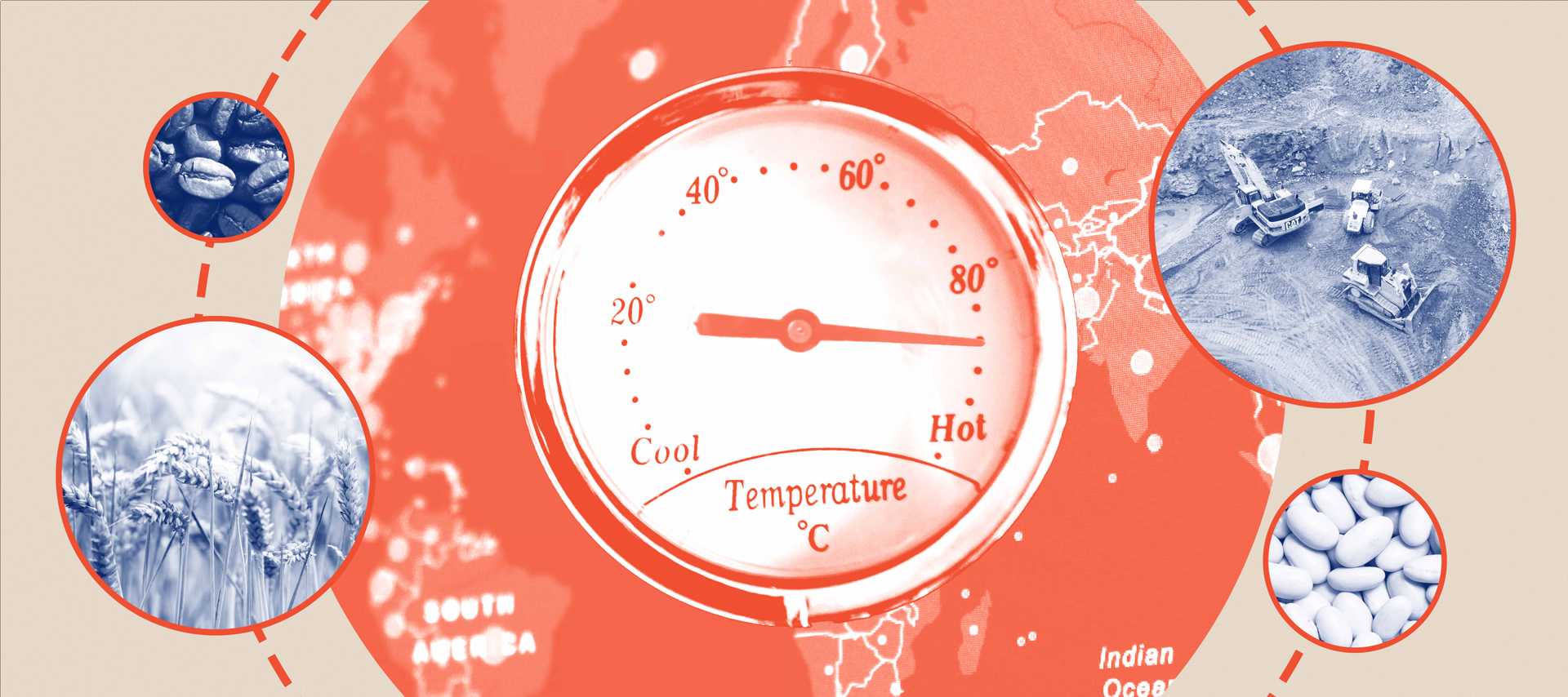How Does El Niño Impact Margin Requirements?
- El Niño has a significant impact on commodity prices
- The most impacted are agricultural products such as soybeans and sugar
- There may be an indirect impact on other commodities such as metals, energy and freight
- Likely increases in prices and volatility will lead to increases in margin requirements
- Liquidity may become an issue – firms should consider their liquidity planning
- Calculating Cash Flow at Risk will be key to ensuring that sufficient liquidity is available to overcome any issues caused by El Niño
The world has almost definitely entered an El Niño phase. This happens when the Pacific Ocean heats up more than usual, raising global temperatures as a result. El Niño impacts circulation by increasing the amount of rising air, clouds, and rain over the warmer than average waters in the central Pacific. The trade winds and the upper-level winds slow, and the overall circulation weakens. The weaker trade winds allow the surface to continue to warm, and a feedback mechanism is born.
An El Niño event increases the tendency for wetter conditions in East Africa and East Asia and drier conditions, including drought, in West Africa, southern Africa, India, Southeast Asia, Australia, northern areas of South America and Central America. El Niño thus tends to amplify the negative effects of climate change in Asia-Pacific, South and East Africa and the Americas.
The length and severity of the El Niño phase both matter. The impact on climate has the potential to significantly disrupt the outlook for consumer staples such as sugar, soybeans, rice, and wheat. The current El Niño was first declared in June and is expected to strengthen throughout the winter months. The weather effects can vary between heavy rainfall and droughts. Droughts can lead to lower production for crops and pasture feed for livestock, whilst warmer weather in the winter can weaken demand for heating fuels such as natural gas.
El Niño affects soft commodities the most, with a strong relationship between El Niño and commodity prices.
So which contracts are going to be most affected and what is likely to be the impact on margins?
The Countries Most Impacted
The four countries most affected by El Niño are Brazil, India, Indonesia and Australia. All of these are major producers of commodities.
Brazil is the world’s leading producer of sugarcane, soya, coffee and orange, whilst India is the world’s number two producer of rice, wheat, sugar cane and potatoes. Indonesia is number one in palm oil and number 3 in rice. Meanwhile, Australia is the number four producer for barley and rapeseed.
These countries alone cover a large percentage of global food production. Poorer harvests will put pressure on agri-food value chains as a whole, and 2024 is likely to be a year of extreme tension between supply and demand for the sector. Disruptions will have a negative impact on major exporting countries (Australia, Brazil, US) and the hot spots that are supposed to be self-sufficient in food (China, India).
Impact By Region
Europe
Europe has seen increased temperatures since May, with over 50 degrees Celsius reached in some parts and wildfires causing devastation. During winter it is expected that El Niño will impact the jet stream, bringing wetter conditions to southern Europe. However, the largest effect could be in northern Europe, where winter is expected to be drier and colder, with a frosty 2023-24 winter season likely if El Niño ramps up sufficiently by then.
North America
In the U.S El Niño is “typically a good thing” for so-called row crop farmers — corn and soybeans. More production could pressure prices for soybeans, which have traded lower in the year to date. Most-active soybean futures traded in Chicago settled as low as $12.65 a bushel this year on June 28, the lowest since December 2021.
Many farmers in the Southeast grow several different crops in a single growing season, such as wheat, soybeans and cotton, with about 68% of all U.S. peanuts being grown in the region. As storms often move up the coast during El Niño winters, the Eastern Seaboard generally experiences above-normal precipitation.
Hawaiian Islands can be at greater risk of hurricanes during El Niño, which will add to the difficulties they have already suffered from wildfires this summer. For other areas of the US, there is a heavy snow potential with a more active storm track across the southern U.S. and the lower Midwest.
South America
El Niño has been good to date for South America. Argentina’s wheat shipments are expected to increase, with the county expected to ship 13.5 million mt, up from 5 million the previous year, based on a likely harvest increase of over 50%.
Meanwhile soybean production and exports are expected to increase in both Brazil and Argentina. Brazil’s raw soybean export is estimated to rise 4% on the year to 96.5 million mt based on a similar rise in output to around 163 million mt. Argentina’s soybean meal shipments are expected to be 24.3 million mt, up 15.2% on the year, while oil exports are projected at 4.5 million mt, up 20%. Argentina is estimated to harvest 48 million mt of soybean, nearly doubling on the year from 25 million mt in the previous season.
The increase in soybean production and crushing is likely to boost global availability of soybean derivatives, thus putting further pressure on prices.
Africa
In East Africa, El Niño generally coincides with heavier rains, starting in September, coinciding with the beginning of the “short” rainy season in the region. This could relieve countries in the Horn of Africa – Ethiopia, Somalia, Kenya – which have been suffering from prolonged drought for several years, at a very high cost in terms of food insecurity and losses of herds and crops.
However, El Niño can bring below-normal rainfall to parts of Southern Africa, particularly countries such as Zimbabwe, Zambia, and Malawi. This can lead to lower agricultural productivity, water scarcity, and an increased risk of wildfires. There is also a risk of disruption to other products, including cocoa from Ivory Coast and Ghana.
Asia
According to the current forecast, the distribution of precipitation over the crops involved in the region (cotton, rapeseed, sugarcane, peanut, and palm oil in Indonesia and Malay, rubber in Thailand, and sugar in Thailand) remains generally favourable for crop growth during the growing or harvesting period.
Rice, 90% of which is produced in Asia and which accounts for 60% of domestic cereal consumption in the region, is very vulnerable to the effects of El Niño as this water-intensive crop is likely to suffer from low levels of rainfall. Furthermore, the weight of food in regional consumer price indices is significant (around 40%), raising fears of a surge in inflation in the medium term.
A mild El Niño could reduce Malaysia’s palm oil production by 10% while a severe one could pull it down by as much as 20%. Meanwhile, in Indonesia, drier weather caused by the El Niño phenomenon may lead to forest fires and threaten harvest, with the production of coffee from Vietnam and Indonesia being threatened.
Australia
Poor rainfall is expected, which is likely to impact Australia’s wheat output. The harvest is expected to be 26.2 million mt, down 33.9% on the year. Wheat exports are also likely to decline to 21mn mt, down 29% on the year, due to the anticipated drop in harvest.
Australia’s cotton production areas are closer to the South Pacific region, and the planting period is in the northern hemisphere winter, which is relatively drought-resistant. With the expectation of a warm winter, the yield will not be affected too much.
India
The weather pattern also has potential to negatively impact wheat and rice production in key growing areas. India, which is the second-largest single country producer of both rice and wheat, consumes nearly all the wheat it produces. If there’s a production shortfall, India may look to import wheat, potentially putting a strain on an already volatile market, with wheat still very sensitive to headlines out of the Black Sea resulting from the war in Ukraine.
India also accounts for 40% of global rice exports and production losses there can have significant impacts on the global rice trade. The country has banned exports of a key variety of rice, cutting overall supplies to world markets by a fifth amid rising domestic prices.
Production declines for either wheat or rice may lead to increased demand for the other, and lead to higher food prices for consumers across the globe.
The last strong El Niño in 2015 to 2016, had the biggest impact on sugar. Prices doubled during this period due to production losses in India, where production accounted for 17% of the global production at the time.
What other commodities might be impacted?
Energy
The influence of El Niño extends to energy markets, particularly those linked to hydroelectric power and natural gas. In regions where hydroelectric power generation holds significant importance, such as South America, reduced rainfall during El Niño can lead to lower water levels in reservoirs, ultimately reducing energy production. As a result, there might be an increased demand for alternative energy sources like natural gas, which can push up prices in the natural gas market.
Lower or higher than expected temperatures because of El Niño are also likely to impact energy prices, with the potential for more fuel being required for heating and cooling.
Mining
El Niño’s impact can also reverberate in metals and mining industries. By triggering heavy rainfall and flooding, El Niño can impede access to mining sites, disrupt supply chains, and hinder the transportation of extracted minerals. These disruptions can lead to reduced output and potential supply shortages, thus driving up prices for metals and minerals.
Other
Moreover, El Niño can exert secondary effects on various commodity markets. For instance, alterations in weather patterns can impact shipping and transportation, potentially influencing the prices of commodities transported by sea. Furthermore, El Niño’s influence on ocean temperatures can affect fish populations, consequently impacting the seafood market.
Impact on Margins and Liquidity
It probably goes without saying that El Niño is going to impact commodities. For most agricultural products the unpredictable and potentially extreme weather events are going to lead to a drop in harvests and therefore place upward pressure on prices. However, as the soybean example shows this is not always the case. Changes from the normal weather patterns can result in increased production and subsequent drops in prices.
The same is also true for commodities impacted indirectly by El Niño, although, from metals to energy and freight to livestock, the usual impact is to reduce availability and therefore push up prices.
With the effects of El Niño being unpredictable, it is not clear by how much prices might be impacted, however it is clear that volatility is likely to increase. And this will impact margin requirements.
Variation Margin (the realised profit and loss on a contract) is impacted by any price moves so El Niño is likely to see increases in margin calls to cover any losses. The firms that will be impacted will depend on the particular products and the side of the market on which they hold positions.
For Initial Margin though all firms are likely to be affected. Requirement levels come from a combination of price moves and volatility, so if the El Niño phase continues as predicted it is likely that margin requirements will increase across the majority of soft commodities.
It is possible that firms who trade commodities will find themselves in a similar position to the energy trading firms last year following the Russian invasion of Ukraine. Large moves in energy prices found them having to meet significant margin calls on the back of variation margin losses and increases in initial margin based on the rising volatility. This was despite the fact that these positions were often part of an overall profit making portfolio, with the profits tied up in longer term OTC contracts.
These issues highlighted the need for liquidity planning; ensuring that sufficient funds are available to meet margin calls under these circumstances. And to understand the likely figures requires complex analysis including the calculation of Cash Flow at Risk. This means not just understanding the likely profits or losses on a portfolio as the usual VaR calculations provides, but knowing potential liquidity requirements under a range of stress scenarios.




